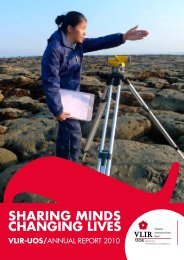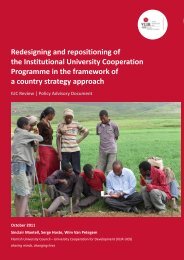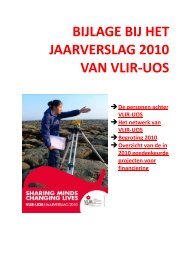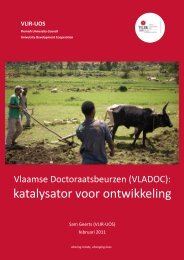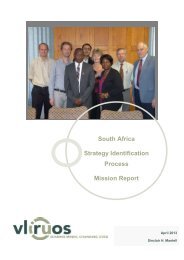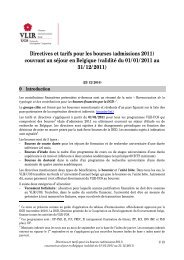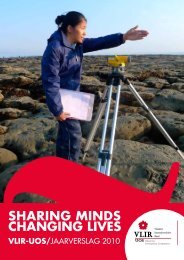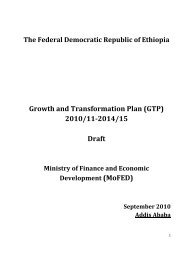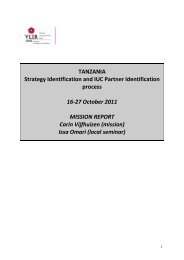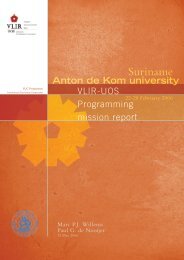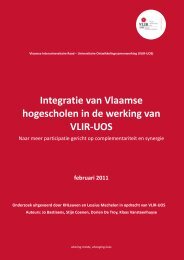Education Sector Development Program - VLIR-UOS
Education Sector Development Program - VLIR-UOS
Education Sector Development Program - VLIR-UOS
Create successful ePaper yourself
Turn your PDF publications into a flip-book with our unique Google optimized e-Paper software.
<strong>Education</strong> <strong>Sector</strong> <strong>Development</strong> <strong>Program</strong> IV<br />
Develop teachers training modules on life skills<br />
based education<br />
Develop supplementary reading materials that<br />
provide practical skills linked to interventions,<br />
e.g., hygiene, malaria prevention<br />
Carry out life skills-based health education<br />
activities with the active participation of school<br />
clubs, in the extra-curricular activities<br />
Train teachers as “main actors” to take lead role<br />
for conducting the life skills- based and behavior<br />
centered health education program (in service<br />
training )<br />
Component 4: Create conducive policy<br />
environment related to SHN<br />
Establish/strengthen sectoral linkages and<br />
collaboration between MOE, MOH and MOWR to<br />
implement SHN in an integrated and organized<br />
manner.<br />
Develop school policies, norms and code of<br />
conduct regarding SHN e.g. use of drug, tobacco<br />
and alcohol, protocols on school infrastructure,<br />
healthy food, orphans and students with disability<br />
and diseases (including HIV/AIDS).<br />
Number of teacher training modules developed<br />
Number of supplementary reading materials<br />
developed<br />
Number of schools with active school clubs in<br />
health and nutrition activities<br />
Number of teachers trained on life skills based<br />
education<br />
Agreement signed and operational guideline<br />
developed between Ministry of <strong>Education</strong>,<br />
Ministry of Health and Water and Sewerage<br />
Authority<br />
Linkage and, networking between MOE, MOH and<br />
MOWR at all levels strengthened<br />
School level SHN policy and guideline established<br />
in all schools<br />
Drug and Substance Abuse Prevention<br />
in <strong>Education</strong><br />
1. Situation Analysis<br />
A historic rapid assessment was conducted on<br />
the situation of drug/substance abuse in 1995.<br />
The assessment covered twenty-five towns and<br />
included various categories of the Ethiopian<br />
population. The categories unequivocally agreed<br />
then khat/Chat, alcohol, tobacco, hashish/<br />
cannabis, and solvents and to a lesser degree<br />
heroin and cocaine were habitually abused<br />
substances. The poor in general, merchants<br />
and their families, street children, students,<br />
commercial sex workers, and the non-merchant<br />
middle class were dependents of the habit<br />
forming substances. But some groups such as<br />
out of school youth, young persons from khat<br />
producing areas, young people at school, working<br />
youth, rural Moslems, and young commercial sex<br />
workers were considered the most vulnerable<br />
groups. The study also unveiled that users of<br />
harmful drugs do not limit themselves to the use<br />
of one substance only. Users of one substance<br />
tend or are motivated to use two or more other<br />
substances to maximize excitement. However,<br />
people combine and use substances that are<br />
common in the market and easily accessible.<br />
Evidently, khat, alcohol and tobacco are easily<br />
accessible physically and in terms of cost.<br />
The message here is that there is a need to<br />
design multifaceted approach to control drug /<br />
substance abuse. For instance, giving license to<br />
sell khat may be considered wrong as it serves<br />
as precursor to combined use of drug/substance.<br />
The city of Addis Ababa and other major regional<br />
towns are the areas most affected by drug abuse,<br />
but this is spreading to other small towns.<br />
Drug and substance abuse affects the health of<br />
the individual abuser. There are several physical<br />
and mental health and nutritional problems<br />
associated with drug abuse. Many drug abusers<br />
suffer reduced productivity, and many lose or quit<br />
their jobs as a direct consequence of drug abuse.<br />
87



